Using pockets of gas found in tiny crystals, scientists have created a timeline for the formation and eruption of four supervolcano events in northern Chile more than twenty million years ago. Plus, rocket launches, gorgeous new space images, and an interview with Jian-Yang Li about the upcoming DART mission’s impact.
Podcast
Show Notes
How to build a supervolcano in just 4 million years
- Supervolcanoes Linger a While, Then Rush to Erupt (Eos)
- “Timescales for pluton growth, magma-chamber formation and super-eruptions,” M. E. van Zalinge et al., 2022 August 3, Nature
Hexagonal diamonds came from dwarf planet
- RMIT University press release
- “Sequential Lonsdaleite to Diamond Formation in Ureilite Meteorites via In Situ Chemical Fluid/Vapor Deposition,” Andrew G. Tomkins et al., 2022 September 12, PNAS
Star birth highlighted in new JWST image
- PDRs4All press release
- James Webb Space Telescope spots baby stars cocooned in the Orion Nebula (Space.com)
Stellar death captured in Chandra image
- CXO press release
- “Evidence for a Dense, Inhomogeneous Circumstellar Medium in the Type Ia SNR 0519-69.0,” Brian J. Williams et al., 2022 August 18, The Astrophysical Journal
New Shepard 23 ends prematurely; crew would have been safe
- Blue Origin press release
- Launch video
SpaceX conducts record-breaking Starlink launch
- SpaceX mission page
- AST SpaceMobile press release
Dragsails to become more common
- Purdue University press release
- Mitigating Orbital Debris by Shortening Time for Satellite Disposal Post-Mission (FCC)
Transcript
There are lots of true statements about our universe: it is big, it is mostly empty, and it is already old but has only lived a fraction of its potential existence. I can say a lot of things, and the reason I can say them is because of the most important fact of all: in all our smallness, humans somehow have the capacity to understand this universe we occupy.
In today’s Daily Space, our news stories sprawl all over science. We start by looking, proverbially, under our own feet as we follow researchers on their journey. to explore the formation of supervolcanoes. With this information about our world, we jump away to look at the formation of actual diamonds on distant words, the formation of stars in nearby nebulae, and the formation of new atoms and shockwaves in middle-aged supernovae remnants.
With astronomy, we are largely stuck just looking at what is there, but in an interview with researcher Jian-Yang Li, Beth reminds us that planetary researchers get to experiment with the objects of our solar system, and the DART mission is about to test our ability to rearrange asteroids – or at least the moons of asteroids – in an upcoming experiment.
Erik will also bring us a look at Blue Origin’s perfectly failing launch and why it’s important for rockets to sometimes fail gracefully.
All of this and more is coming to you today on the Daily Space. I am your host Dr. Pamela Gay, and we are here to put science in your brain.

If you’re a regular member of our community, you know that Beth and I stan volcanoes – from the liquid flow of Hawai’i and Iceland to the explosive bursts of Etna and Pinatubo – so long as lives aren’t lost. One thing we, thankfully, haven’t had to experience in our lifetimes is the eruption of a supervolcano. Every so often, though, scientists like to remind us that we are overdue for a supervolcano eruption. On average, they tend to occur every 20,000 years, and the last one was 27,000 years ago.
To keep us from panicking too badly, researchers have been studying a variety of features from known supervolcano eruptions to get a better understanding of just how often they occur and possibly what signs we can look for in advance.
In a new paper in Nature, a team of scientists recently published an analysis of tiny zircon and feldspar crystals from four known eruptions in northern Chile. Using argon-argon dating, the team was able to determine that the crystals formed underground in large plutons that cooled slowly until magma welled up through weak spots. The granite fragmented and remelted, and then pooled in giant underground lakes, eventually erupting explosively and leaving behind giant caldera.
The process began more than four million years before the first of the four eruptions, giving the granite plenty of time to slowly cool. However, the magma melting and pooling took an incredibly short time – possibly only years to decades.
After the eruption, the process began anew, with magma welling up, forming another pluton over millions of years, and then breaking up, remelting, building a lake, and exploding all over. The last of these four eruptions occurred 19.6 million years ago.
And so far, no one has seen definitive signs that any of the known supervolcanoes around the world are a threat. But now we have more insight into one of the possible processes that we can keep an eye out for.
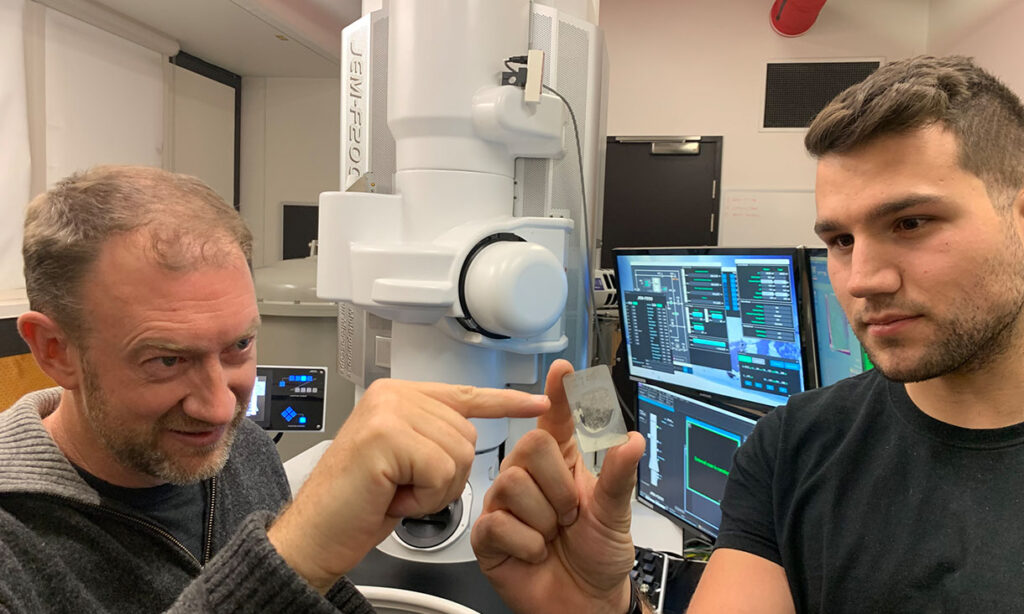
Analyzing tiny crystals is a great way to understand the conditions under which a crystal formed, especially if you can analyze gas pockets locked within the crystal. And now a team of researchers has found rare hexagonal diamonds called lonsdaleite inside a particular type of meteorite called a ureilite. We’ve talked about these particular meteorites before in the context of finding even wilder carbon molecules called Buckyballs.
According to the new paper published in the Proceedings of the National Academy of Sciences (PNAS), these strange diamonds may even have had an even wilder extraterrestrial origin than a simple asteroid. The scientists involved found that the diamonds may have formed in the very early days of our solar system, about 4.5 billion years ago. Even wilder, are the circumstances under which they formed. Co-author Dougal McCulloch explains: There’s strong evidence that there’s a newly discovered formation process for the lonsdaleite and regular diamond, which is like a supercritical chemical vapor deposition process that has taken place in these space rocks, probably in the dwarf planet shortly after a catastrophic collision.
And they used a similar process in the lab to grow similar diamonds, using a specialized chamber. Lead author Andrew Tomkins explains: …the team proposed that lonsdaleite in the meteorites formed from a supercritical fluid at high temperature and moderate pressures, almost perfectly preserving the shape and textures of the pre-existing graphite. Later, lonsdaleite was partially replaced by diamond as the environment cooled and the pressure decreased.
The team hopes that this process can be used to manufacture incredibly hard but tiny machine parts for various industries.
And to think… all this amazing science came from microscopic crystals in old rocks.
Our universe is, in many ways, the largest 3D printer of them all. It doesn’t necessarily build things up layer by layer, but it does build up materials, element by element.
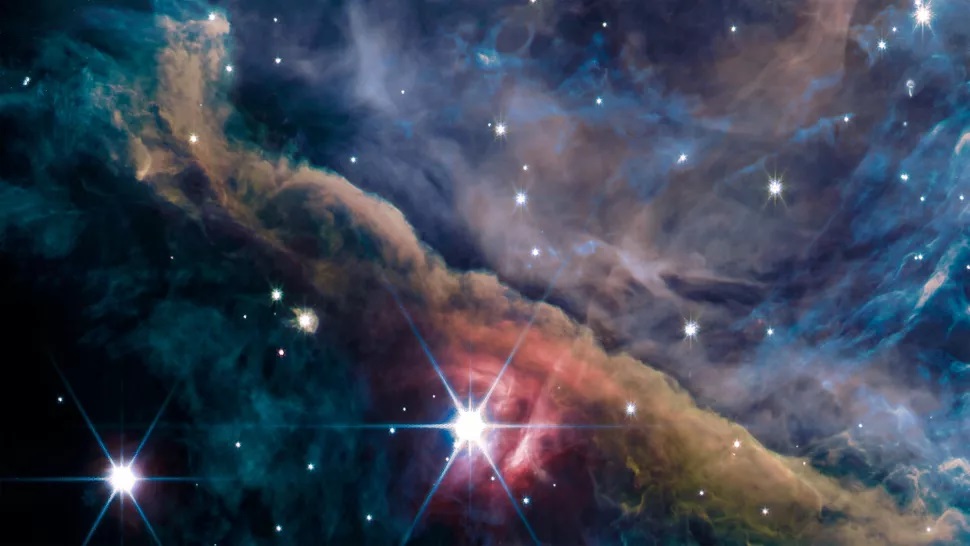
In the latest image released by the JWST, researchers captured solar system-sized details in the relatively nearby Orion Nebula. Located 1,350 light-years away, this region of dust, gas, and young stars allows us to see what the region our own Sun formed in may have looked like. This image was obtained for a team that includes Edwin Bergin, who explains: We hope to gain understanding about the entire cycle of star birth. In this image, we are looking at this cycle where the first generation of stars is essentially irradiating the material for the next generation. The incredible structures we observe will detail how the feedback cycle of stellar birth occurs in our galaxy and beyond.
The stars we see forming in Orion today will generally go on to live millions to trillions of years. The length of a star’s life is determined by its mass and its environment. A star like our Sun, for instance, will eventually stop generating energy using fusion, and when its nuclear reactor turns off, the entire star will collapse down into a white dwarf roughly the volume of the Moon. The white dwarf is extremely stable and could hang out, cooling off, essentially until the end of time. The catch is that it can only do this in isolation.
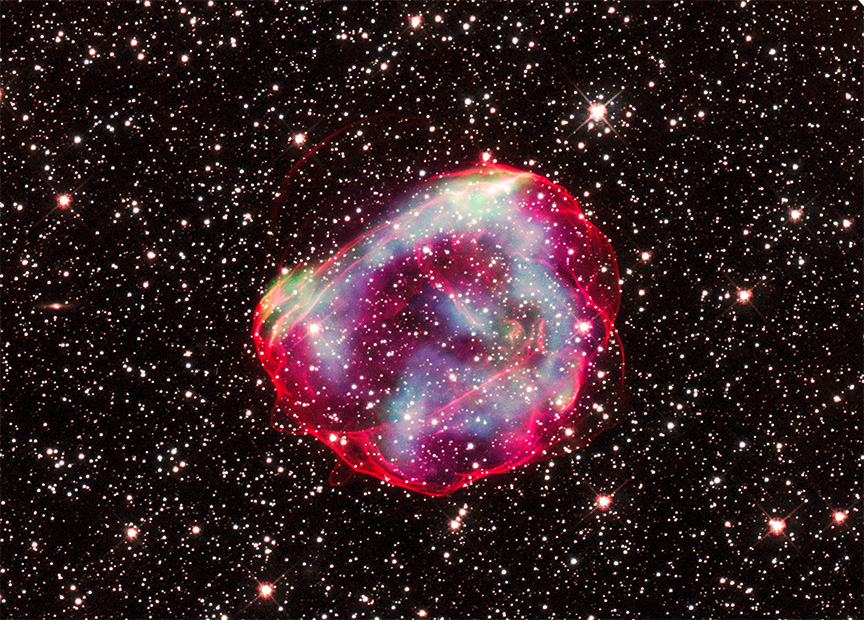
If a white dwarf has a companion that gets too close, it will gravitationally tear off that companion’s outer layers and increase in mass until it becomes unstable and explodes as a supernova. In a new image from Chandra, the delicate cloud of material from such a supernova shines in X-ray and optical light. The original white dwarf exploded 670 years ago, and today, its shock waves continue to expand outward at rates from 3.8 to 5.5 million miles per hour. This rate is slowing over time as the blast pushes out more and more material.
These images and the physics of the nearby explosion are discussed in a new paper in The Astrophysical Journal, led by Brian Williams. Someday, the clouds of compressed material, enriched by the supernova’s heavy elements, will become the building blocks of future generations of stars.
From the structures that make up planets and the stars that live and die to support those planets, we now turn to planetary defense. Joining our own Beth Johnson to discuss the DART mission and its upcoming asteroid boop is Jian-Yang Li. Stay tuned to learn what NASA plans to knock an asteroid’s moon into a new orbit. Then, later in the show, we’ll be joined by Erik Madaus for a look at the rocket community’s most recent attempt to leave our planet. Spoiler alert: One of them failed in the safest way possible.
Interview
One of the big planetary science highlights this year is the much anticipated DART mission, which launched in November 2021 and is due to impact the tiny moonlet Dimorphos orbiting the asteroid Didymos on September 26, 2022. Joining me today to talk about this mission is Jian-Yang Li, a senior scientist at the Planetary Science Institute who is also a DART investigation team member, leading the Hubble Space Telescope observations of the DART impact ejecta.
Welcome, Jian-Yang, and thank you for joining me today.
[Listen to the full interview.]
Once again, thank you for speaking with me today, Jian-Yang, and good luck with the post-impact measurements.
Now it’s time we turn to Erik Madaus and the rocket launches from the last week, including that one that failed perfectly.
Rocket News
Last week, we mentioned that Blue Origin’s New Shepard 23 (NS-23) mission had not launched, yet. Then, on September 12, it launched. First, you should know that it was not carrying any humans, only some science experiments for NASA.
However, the flight did not go very well. Well, it did go very well in that its automatic fault detection and launch abort system worked flawlessly, but the mission as a whole was a failure. Happily, no injuries were reported.
At T plus 1 minute 4 seconds, around the maximum dynamic pressure (max-q) – the point of peak mechanical stress on the structure – the propulsion module’s single BE-3 engine failed in a burst of yellow flame, and the rocket began to yaw. Moments later, the booster was enveloped in smoke as the capsule’s launch abort motor fired, pulling the capsule safely away. The capsule reached an apogee of around 12 kilometers before landing safely under parachutes a few minutes later. This was the first launch failure of a New Shepard rocket.
The New Shepard propulsion module, which does not have an explosive flight termination system, blew up when it impacted the ground. It did not explode in mid-air as such a debris cloud would have been noticed on weather radar and nothing like that was detected. The webcast briefly showed its speed on the way down, indicating Blue Origin was still receiving telemetry until the end. A previous deliberate in-flight abort test conducted during the development of New Shepard also left the propulsion module intact after the capsule departed.
The booster on NS-23 was Booster 3, specifically designated for launching uncrewed missions. This was only its 9th flight. Booster 4, the other active booster in the New Shepard fleet, has been used on one uncrewed test and six crewed flights. According to a statement from the Federal Aviation Administration, the agency is supervising Blue Origin’s failure investigation and will not allow them to return to flight until they are satisfied the issue is fixed.
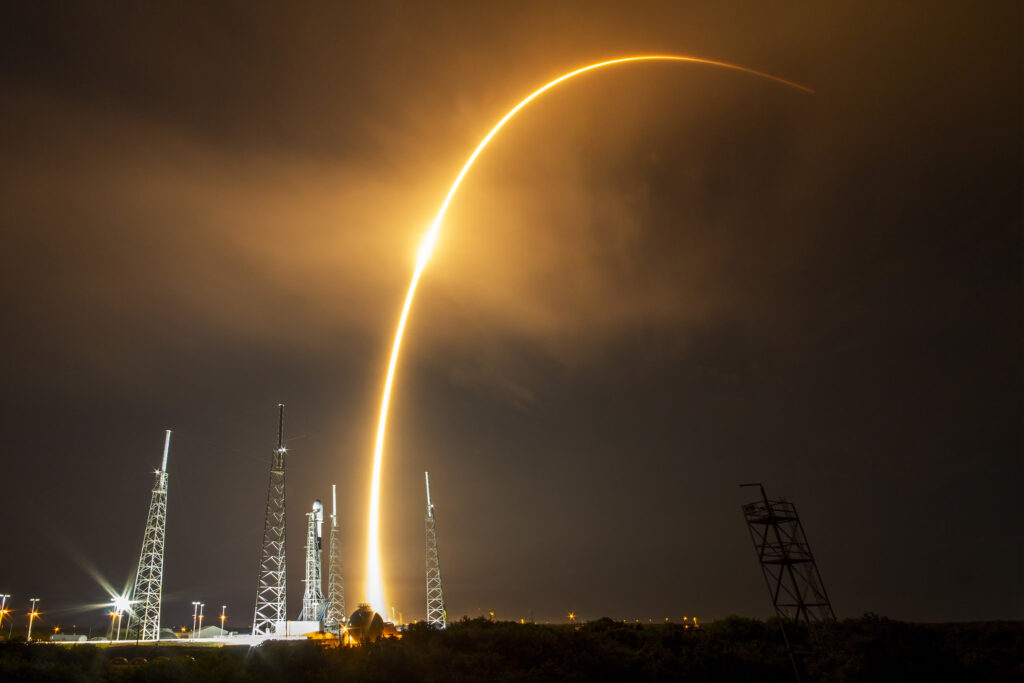
SpaceX launched yet another Starlink mission this past Saturday the 10th. Instead of the usual fifty-something satellites, this flight only carried 34 Starlinks and one large rideshare called Blue Walker 3.
Blue Walker 3 is a prototype communication satellite for AST SpaceMobile, which hope to use a constellation of gigantic satellites to deliver 4G or 5G service directly to cell phones without the need for ground stations or cellphone towers. Bluewalker 3 is a prototype and only 64 square meters in area when unfolded; the operational satellites will be even bigger.
Booster 1051 completed its record fourteenth flight with a landing on the droneship A Shortfall of Gravitas. The Falcon 9 upper stage responsible for delivering the satellites into orbit set a record of its own, igniting five times over the course of the mission to deliver the 35 satellites into two different orbits before sending itself back into the atmosphere over the Pacific. That is the most number of Merlin Vacuum ignitions in a single mission.
In related space news, a NASA-funded dragsail could see commercial orders as soon as next year.
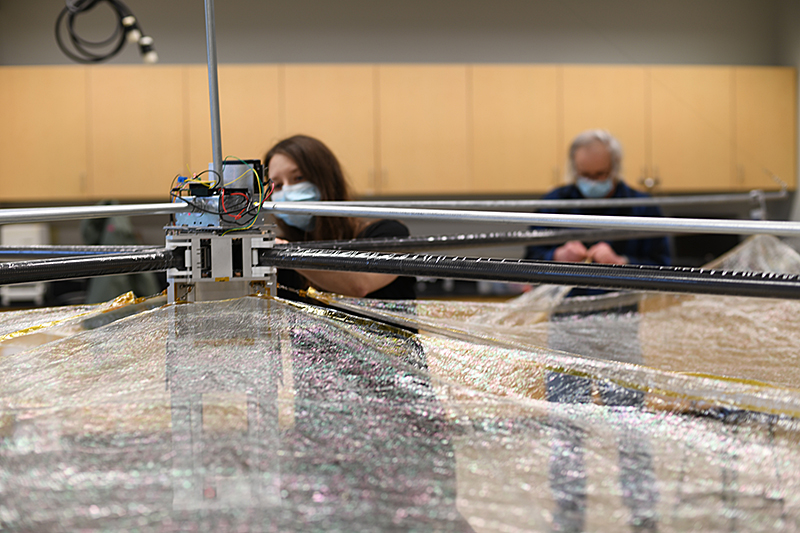
A dragsail is a large area of flexible material designed to compress in a spacecraft and once the satellite’s mission is over, expand to ensure it decays from Earth orbit as fast as possible. Previously, these have been bespoke structures made for a few satellites mainly as a test. Now a company called Vestigo Aerospace is making a line of standardized sails called Spinnaker, able to be installed on any spacecraft. The work is funded through a NASA Small Business Innovation Research (SBIR) grant award plus some private investment. This Phase 2E grant follows two previous rounds of SBIR funding and other private investments.
The Federal Communications Commission (FCC) is the agency delegated to manage the permits for satellite communications in the U.S. The current FCC regulations mandate that all defunct satellites owned by American companies below 600 kilometers decay from orbit in less than 25 years, with special incentives for smallsats that decay in six years.
The FCC is currently in the process of reducing that timeline for all satellites operated by U.S. companies – and other satellites seeking to provide service to customers in the U.S. – to five years. The reason for the updated regulation is that Low Earth Orbit is much more crowded than it was at the time of the original regulation. Half of the approximately 4,800 active satellites in Low Earth Orbit have been launched in the last two years. They have clustered at an altitude of just under 600 kilometers to comply with the regulation without any special effort. This increases collision risk due to the sheer number of satellites in that orbit.
The new regulation, once it’s put into force, will exempt all current satellites and all satellites launched two years after it goes into effect from the requirements. Once it goes into effect, scientific and other research satellites will be able to apply for waivers in their special cases. The FCC has been working with the industry since 2018 on the new rule. The final rule could be officially adopted this month during the monthly meeting of the FCC.
And when they start launching, we’ll bring it to you here.
For now, though, this has been the Daily Space.
You can find more information on all our stories, including images, at DailySpace.org. As always, we’re here thanks to the donations of people like you. If you like our content, please consider joining our Patreon at Patreon.com/CosmoQuestX.
Credits
Written by Pamela Gay, Annie Wilson, Beth Johnson, Erik Madaus, and Gordon Dewis
Hosted by Pamela Gay, Beth Johnson, and Erik Madaus
Audio and Video Editing by Ally Pelphrey
Content Editing by Beth Johnson
Intro and Outro music by Kevin MacLeod, https://incompetech.com/music/


 We record most shows live, on Twitch. Follow us today to get alerts when we go live.
We record most shows live, on Twitch. Follow us today to get alerts when we go live.